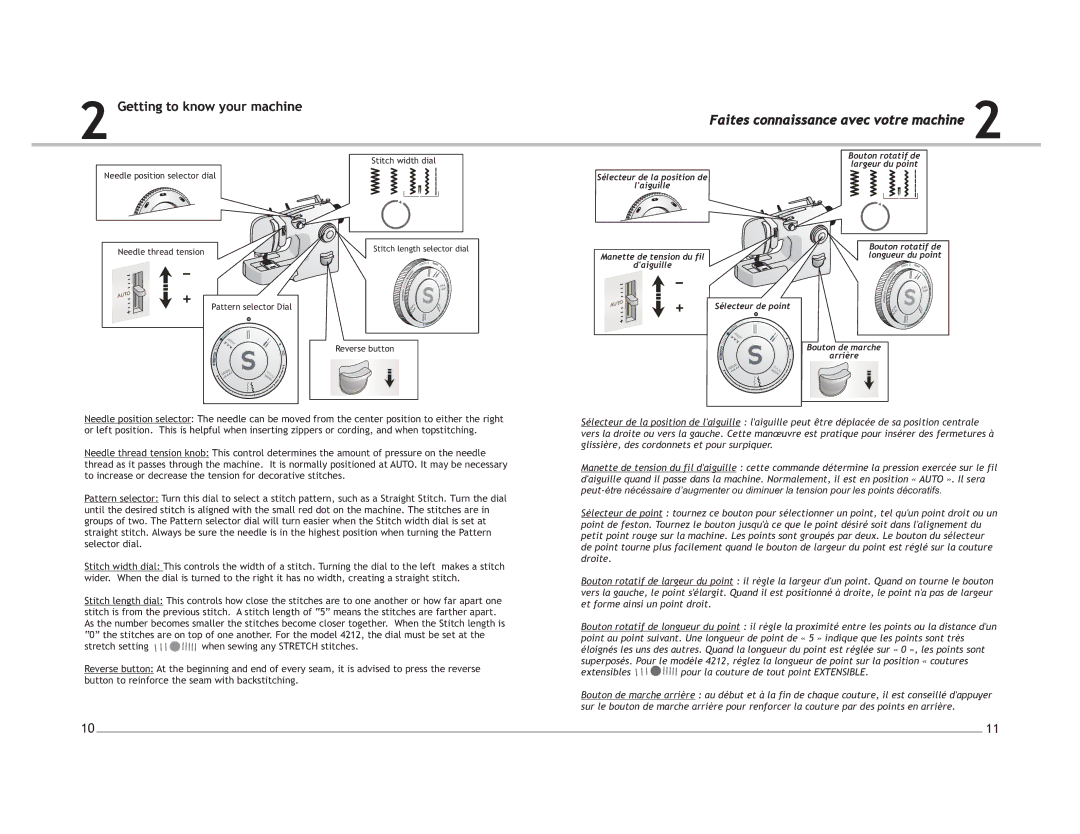
2 Getting to know your machine
Stitch width dial
Needle position selector dial
Needle thread tension | Stitch length selector dial |
| |
AUTO |
|
Pattern selector Dial | |
| 0 |
H | Reverse button |
C |
|
T |
|
E |
|
R |
|
T |
|
S | 1 |
| 5 |
| 2 |
| 4 |
| 3 |
Needle position selector: The needle can be moved from the center position to either the right or left position. This is helpful when inserting zippers or cording, and when topstitching.
Needle thread tension knob: This control determines the amount of pressure on the needle thread as it passes through the machine. It is normally positioned at AUTO. It may be necessary to increase or decrease the tension for decorative stitches.
Pattern selector: Turn this dial to select a stitch pattern, such as a Straight Stitch. Turn the dial until the desired stitch is aligned with the small red dot on the machine. The stitches are in groups of two. The Pattern selector dial will turn easier when the Stitch width dial is set at straight stitch. Always be sure the needle is in the highest position when turning the Pattern selector dial.
Stitch width dial: This controls the width of a stitch. Turning the dial to the left makes a stitch wider. When the dial is turned to the right it has no width, creating a straight stitch.
Stitch length dial: This controls how close the stitches are to one another or how far apart one stitch is from the previous stitch. A stitch length of “5” means the stitches are farther apart. As the number becomes smaller the stitches become closer together. When the Stitch length is “0” the stitches are on top of one another. For the model 4212, the dial must be set at the
stretch setting ![]()
![]()
![]()
![]()
![]()
![]()
![]()
![]()
![]() when sewing any STRETCH stitches.
when sewing any STRETCH stitches.
Reverse button: At the beginning and end of every seam, it is advised to press the reverse button to reinforce the seam with backstitching.
Faites connaissance avec votre machine 2
Bouton rotatif de largeur du point
Sélecteur de la position de
l'aiguille
|
|
| Bouton rotatif de |
Manette de tension du fil |
|
| longueur du point |
d'aiguille |
|
|
|
AUTO | Sélecteur de point |
| |
|
| 0 | Bouton de marche |
| T |
| |
| H |
|
|
| C |
| arrière |
| E | 1 | |
| S | ||
| R |
|
|
| T |
|
|
|
| 5 |
|
|
| 2 |
|
|
| 4 |
|
|
| 3 |
|
Sélecteur de la position de l'aiguille : l'aiguille peut être déplacée de sa position centrale vers la droite ou vers la gauche. Cette manœuvre est pratique pour insérer des fermetures à glissière, des cordonnets et pour surpiquer.
Manette de tension du fil d'aiguille : cette commande détermine la pression exercée sur le fil d'aiguille quand il passe dans la machine. Normalement, il est en position « AUTO ». Il sera
Sélecteur de point : tournez ce bouton pour sélectionner un point, tel qu'un point droit ou un point de feston. Tournez le bouton jusqu'à ce que le point désiré soit dans l'alignement du petit point rouge sur la machine. Les points sont groupés par deux. Le bouton du sélecteur de point tourne plus facilement quand le bouton de largeur du point est réglé sur la couture droite.
Bouton rotatif de largeur du point : il règle la largeur d'un point. Quand on tourne le bouton vers la gauche, le point s'élargit. Quand il est positionné à droite, le point n'a pas de largeur et forme ainsi un point droit.
Bouton rotatif de longueur du point : il règle la proximité entre les points ou la distance d'un point au point suivant. Une longueur de point de « 5 » indique que les points sont très éloignés les uns des autres. Quand la longueur du point est réglée sur « 0 », les points sont superposés. Pour le modèle 4212, réglez la longueur de point sur la position « coutures
extensibles 







 pour la couture de tout point EXTENSIBLE.
pour la couture de tout point EXTENSIBLE.
Bouton de marche arrière : au début et à la fin de chaque couture, il est conseillé d'appuyer sur le bouton de marche arrière pour renforcer la couture par des points en arrière.
10 |
| 11 |
